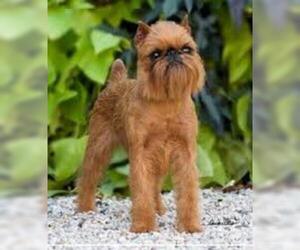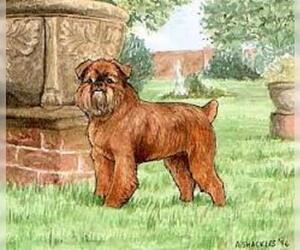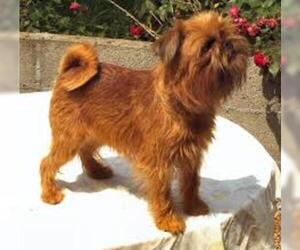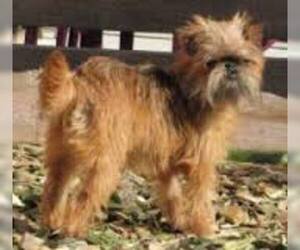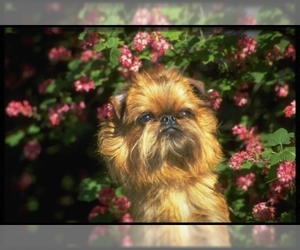
All about Brussels Griffon dog breed
A.K.A. :Griffon Bruxellois, Griffon Belge, Petit Brabançon, Griff, Monkey Face, Dog with a Human Face, Belgian Griffon, Miniature Griffon, Little One, Belgian Toy Dog, Brabançon Griffon, Brussels, Griffon
Size
Grooming requirements
Exercise requirements
Good with other dogs
Watchdog ability
Energetic
Training requirements
Playful
Affectionate
Good with other pets
Good with children
Good with strangers
Winter
Summer
Healthiness
Protective
Life Span
| Pure Breeds | Member |
| Breeds A - Z | B |
| Breeds by Group | Companion Toy |
| Breeds by Trait | Hypoallergenic Low Shedding |
| Overview: | The adorable Brussels Griffon is a charming, small toy breed originating from Belgium, initially bred to hunt vermin in stables. Their distinctive appearance features a compact, sturdy body, a domed head, and large, expressive eyes that give them an almost human-like gaze. They come in two coat types: rough (wiry and dense) and smooth (short and glossy), both requiring regular grooming to maintain. Temperamentally, Griffons are known for being affectionate, intelligent, and highly social, often forming strong bonds with their owners. While generally good with older, considerate children, their small size makes them more suitable for families with respectful kids or individuals. They adapt well to apartment living due to their modest exercise needs and desire to be close to their human companions. Key health considerations for the breed include brachycephalic airway syndrome, patellar luxation, and eye problems. Despite these, with proper care, a Griffon can be a delightful and long-lived companion. |
F.A.Q.
All You Need to Know About the Brussels Griffon Breed
The Brussels Griffon is a charming, intelligent toy breed originating from Belgium, known for its distinctive human-like expression and spirited personality. These small but sturdy dogs come in both rough (wiry) and smooth (sleek) coats, typically red, black, black and tan, or belgium (reddish-brown). Their affectionate and somewhat mischievous temperament makes them delightful companions, often forming strong bonds with their owners. Brussels Griffons are well-suited for apartment living and families with older children due to their compact size and need for moderate exercise – a daily walk and indoor play suffice. Grooming varies; rough coats require regular stripping or clipping, while smooth coats need minimal brushing. Potential owners should be aware of common health concerns like patellar luxation, eye problems, and brachycephalic airway syndrome, particularly in rough-coated varieties. Their charming demeanor and adaptability make them a wonderful choice for those seeking a unique and devoted canine friend.Brussels Griffon Weight: The average healthy weight for an adult Brussels Griffon is typically between 8 to 10 pounds. While there isn't a significant weight difference between males and females, individual size can vary slightly within this range, ensuring a compact yet sturdy build. For potential adopters, this provides a clear understanding of the breed's average size.
Here's a clear and informative answer for your FAQ section:How tall is a Brussels Griffon? What's the average Brussels Griffon height?When considering a Brussels Griffon height for your home, you'll find these charming little dogs are quite compact. The average size of a fully grown Brussels Griffon typically ranges from 7 to 10 inches tall at the shoulder. This measurement is taken from the ground up to the highest point of their shoulder blades.While there isn't a significant difference in Brussels Griffon height between males and females, individual genetics can certainly play a role. Some Griffs might mature at the lower end of the spectrum, around 7 inches, while others might reach the taller 10-inch mark. Don't be surprised if you encounter a slightly smaller or larger individual; it's all part of their unique charm! When you're asking "how tall is a Brussels Griffon?", remember they're bred to be small, sturdy companions.
Brussels Griffon Colors: A Comprehensive GuideBrussels Griffon coats come in a beautiful array of colors, from classic standards to rare and exotic variations. Understanding these "Brussels Griffon colors" is key for potential adopters and buyers comparing coat types and pricing.The AKC recognized Brussels Griffon colors are:* Red: A rich, reddish-brown.* Black: A solid, deep black.* Black and Tan: A striking combination of black with tan markings, typically on the muzzle, chest, legs, and under the tail.* Belgian (Reddish-brown with a black mask): This is often referred to as "Belgian Griffon" color, characterized by a red base with a distinct black mask and sometimes black tipping.These four are the most commonly seen and officially accepted by major kennel clubs like the AKC. When searching for "AKC recognized Brussels Griffon colors," these are the primary options.Beyond the official standards, several rare coat types and exotic Brussels Griffon variations can appear due to recessive genes, though they are not accepted for show by the AKC and other major kennel clubs. These include:* Fawn: A pale, yellowish-tan, sometimes appearing cream. While fawn can be a part of the "Red" spectrum, a very light, almost dilute fawn is considered less common.* Cream/White: While some lighter reds might appear creamy, a true cream or white Brussels Griffon is very rare and generally considered a disqualifying fault in the show ring.* Brindle: A coat with irregular stripes of different colors, often darker stripes on a lighter background. While present in some related breeds, it's not standard for Brussels Griffons.* Blue/Dilute Black: A grayish-blue color, resulting from a dilute gene acting on black pigment. This is an exotic Brussels Griffon variation and quite rare.* Lilac/Isabella: A dilute of chocolate, appearing as a pinkish-gray or brownish-gray. Like blue, this is a very rare and exotic Brussels Griffon variation.* Chocolate/Liver: A brown color, differing from the standard red. While reds can have brown tones, a true chocolate Brussels Griffon is not standard.* Merle: A pattern characterized by patches of dilute color against a solid background, often with blue or odd-colored eyes. This is a highly rare coat type and is generally associated with health concerns in many breeds, so responsible breeders avoid it.While these non-standard "Brussels Griffon colors" can be intriguing, potential buyers should be aware that dogs with these coats may come from less rigorous breeding programs and may not be eligible for AKC conformation events. Pricing for rare or exotic colors can vary significantly, sometimes being higher due to their novelty, or lower if the breeder is less reputable. Always prioritize health and temperament when choosing a Brussels Griffon, regardless of coat color.
The Brussels Griffon personality is marked by a confident, affectionate, and often comical nature. They are intensely loyal and bond deeply with their families, thriving on companionship. Highly sociable, they generally enjoy being part of all household activities. Their adaptable nature makes them excellent apartment dwellers, though they appreciate regular walks and playtime. They are known for being friendly and can coexist peacefully with other pets when properly introduced. Regarding children, they tend to do best in homes with older, respectful children who understand how to interact gently with a small dog. Their intelligent and curious temperament of Brussels Griffon makes them engaging companions, always eager to please and participate.
Brussels Griffon Temperament:The Brussels Griffon temperament is characterized by a charming mix of intelligence, affection, and spunk, making them delightful companion dog behavior. These small but mighty dogs are known for their loyal and devoted nature, forming strong bonds with their families. They are generally friendly and sociable, thriving on human interaction and often displaying an amusing, almost human-like expression.Their adaptability makes them excellent choices for apartment living, as long as they receive adequate attention and daily walks. While typically good-natured, their strong personalities can lean towards a touch of stubbornness, requiring consistent and positive training. They are also quite sensitive and responsive to their owner's moods.Regarding children, a well-socialized Brussels Griffon can coexist happily with older, respectful children. However, due to their small size and sometimes delicate frame, they are generally not recommended for very young children who may not understand how to interact gently. With other pets, they can be sociable, especially if introduced early, though some may exhibit a "big dog in a small body" attitude towards larger canines. Their intelligence and desire to be involved make them engaging and rewarding companions for those seeking a unique and affectionate breed.
Brussels Griffon Care: Your Guide to a Happy, Healthy CompanionBrussels Griffon care involves specific attention to their unique needs. Daily maintenance is crucial for this charming, small breed.Grooming Needs: Both rough and smooth coats require regular attention. Rough coats need weekly brushing to prevent mats and professional stripping or hand-stripping every few months to maintain texture and remove dead hair. Smooth coats are low-shedding but benefit from weekly brushing to remove loose hair and keep their coat shiny. Regular nail trims are essential, typically every 2-4 weeks, as well as occasional paw pad trimming.Exercise Limitations: Brussels Griffons are a low-energy dog breed. They thrive on short, daily walks and indoor play. Their small size makes them well-suited for apartment living. Over-exercising should be avoided, especially in hot weather, due to their brachycephalic (short-nosed) anatomy.Dietary Considerations: A high-quality, small-breed specific dog food is recommended. Portions should be carefully controlled to prevent obesity, as they are prone to weight gain. Treats should be given sparingly. Consult your veterinarian for personalized dietary advice.Wrinkle and Ear Cleaning: Their facial wrinkles, especially around the nose, require regular cleaning to prevent skin infections. Use a damp cloth or pet-safe wipe daily. Their ears should be checked weekly for redness, odor, or discharge, and cleaned gently with a vet-approved solution as needed. This prevents common skin issues.Climate Sensitivity: Due to their brachycephalic anatomy, Brussels Griffons are highly sensitive to extreme temperatures, especially heat. They can overheat quickly and are prone to respiratory distress. Keep them indoors during hot weather and provide a cool environment. In cold weather, ensure they have appropriate protection like a sweater or coat.Common Health Concerns & Health Tips for Brussels Griffon: Beyond climate sensitivity, watch for dental care issues. They are prone to dental disease, so daily tooth brushing with dog-specific toothpaste is highly recommended. Regular veterinary check-ups for dental cleanings are often necessary. Weight management is crucial as obesity exacerbates existing health issues. They can also be susceptible to patellar luxation, eye problems (like cataracts and progressive retinal atrophy), and certain heart conditions. Regular veterinary check-ups are vital for early detection and preventative care, ensuring a long and healthy life for your Brussels Griffon.
The Brussels Griffon activity level is moderate, striking a balance between playful bursts and long periods of rest. They are not high-energy dogs, making their exercise needs relatively easy to meet. Daily activity typically involves a couple of short walks (15-20 minutes each) to explore and stretch their legs, plus some indoor playtime. Brussels Griffons enjoy interactive games like fetch or chasing toys, and they thrive on human companionship during these sessions. They are known for their clownish antics and can entertain themselves with toys for a while, but truly prefer engaging with their family.How active are Brussels Griffon? They are generally calm indoors, often found napping on a lap or curled up in a cozy spot. This makes them surprisingly suitable for both moderately active individuals and those with a more relaxed lifestyle. Their brachycephalic (short-nosed) anatomy is a key consideration: they are highly sensitive to heat and overexertion, especially in warm weather. Strenuous exercise, long runs, or activities in high temperatures should be strictly avoided to prevent respiratory distress. Their small size also makes them less suited for rough play or very active, boisterous families with larger dogs or young children who might accidentally injure them. Instead, they excel in low-key households that appreciate their charming, affectionate nature and are happy with gentle play and plenty of snuggle time. They are not a breed for marathons, but rather for joyful, short sprints and extensive periods of loving companionship.
Breed Breakdown: What Experts Say About the Brussels Griffon
I would rate the Brussels Griffon's "Size" trait a 2.This breed is unequivocally on the extremely small end of the canine spectrum. Their average height typically ranges from 7 to 10 inches at the shoulder, and their weight usually falls between 8 to 12 pounds. Their body structure is compact and sturdy for their size, but inherently delicate due to their diminutive dimensions. Compared to most companion dogs, even other small breeds, the Brussels Griffon stands out as particularly petite. For instance, they are noticeably smaller than a Shih Tzu or a Bichon Frise. Their exceptionally small size makes them incredibly well-suited for apartment living, frequent travel, and households with significant space constraints, as they require minimal physical space and are easy to transport.
I would rate the Brussels Griffon's "Grooming Requirements" an 8/10.The Brussels Griffon is a delightful breed, but their grooming needs lean towards the high-maintenance end of the spectrum compared to many other companion dogs. Their defining characteristic, the wiry rough coat, requires regular attention to prevent matting and maintain its distinctive texture. This involves weekly brushing, and more significantly, hand-stripping every 2-4 months. Hand-stripping is a specialized technique to remove dead hair, encouraging new growth and preserving the coat's wiry feel; simply clipping will soften the coat and alter its appearance. Even the smooth-coated variety, while requiring less brushing, still sheds moderately. Beyond the coat, their brachycephalic (short-nosed) features often necessitate daily cleaning of facial folds to prevent irritation and infection. Regular ear cleaning is important, as is consistent nail trimming to avoid overgrowth. While not exceptionally prone to skin issues, their facial folds can be a hotspot for moisture and bacterial growth if not diligently maintained. They are not a "wash and wear" dog and often benefit from professional grooming or dedicated owner effort to keep them looking and feeling their best.
I would rate the Brussels Griffon's "Exercise Requirements" a 3.While energetic and playful, their small size and brachycephalic (short-nosed) anatomy mean their physical demands are quite low. They thrive on short, daily walks (20-30 minutes is often sufficient) and plenty of indoor playtime. Their energy is more burst-like, preferring quick games of fetch or chasing toys to sustained, long-distance activities. Excessive heat or strenuous exercise can quickly lead to respiratory distress, so owners must be mindful of their limitations. While they can enjoy beginner agility or obedience, these activities are more for mental stimulation and bonding than to meet a high physical need. They are perfectly content with snuggling on the couch and don't require structured, demanding routines to stay healthy and mentally stimulated, though consistent, moderate activity is important to prevent obesity.
I'd rate the Brussels Griffon's "Watchdog Ability" at a strong 8 out of 10.Despite their small size, Brussels Griffons are surprisingly effective watchdogs. They are incredibly alert and possess a keen awareness of their surroundings. Any unusual sound, unfamiliar person approaching the home, or even a leaf blowing unexpectedly will likely trigger a prompt and surprisingly loud, insistent bark. They are not shy about voicing their concerns and often have a "bigger dog" personality when it comes to defending their perceived territory (which is usually the entire house). While they might not be physically intimidating enough to deter a determined intruder, their persistent and high-pitched barking serves as an excellent early warning system. They're more than just passive companions; they are highly attuned to changes in their environment and readily communicate those changes, making them very capable of providing meaningful early warnings in a home environment.
I would rate the "Good with Other Dogs" trait of the Brussels Griffon breed a 7 out of 10.Brussels Griffons generally have a good disposition towards other dogs, often enjoying canine companionship. They are typically not an aggressive or dominant breed, and many thrive in multi-dog households. Their playful and affectionate nature can make them quite adaptable to living with other canines, even those of different sizes, as long as the other dog is not overly boisterous or aggressive. However, their small size and sometimes feisty personality mean they can be easily intimidated by very large or high-energy dogs if not properly introduced. They aren't usually the type to initiate conflict, but they will stand their ground if challenged. While generally sociable, careful introductions are always recommended to ensure peaceful coexistence, especially with unfamiliar dogs, and early socialization is beneficial to foster their naturally friendly tendencies. They tend to do best with other dogs who respect their sometimes delicate stature and don't overwhelm them with excessive rough play.
I would rate the Brussels Griffon's "Energetic" trait as a 4 out of 10.While undoubtedly playful and often quite feisty for their size, Brussels Griffons are not a high-energy breed in the typical sense. They enjoy short bursts of activity, a good romp with their owner, and are certainly not couch potatoes, but their endurance is quite limited. They are more naturally active and curious than, say, a Basset Hound, but significantly more laid-back than a Jack Russell Terrier. Their brachycephalic (short-nosed) anatomy plays a significant role in this rating; it directly impacts their stamina and exercise tolerance. They are prone to overheating and respiratory distress with prolonged or intense physical activity, making them unsuitable for extensive outdoor or athletic endeavors. They much prefer interactive play indoors or short, leisurely walks to long hikes or competitive dog sports. Their need for physical stimulation is met with regular, but not excessive, engagement.
I'd rate the Brussels Griffon's "Training Requirements" a 6 out of 10.While intelligent and capable of learning, the Brussels Griffon also possesses a strong-willed, independent, and sometimes stubborn streak that can make training more challenging than with highly biddable breeds. Their attention span can be short, especially if they're not highly motivated, and they may decide that a command isn't worth their effort at a given moment. They respond exceptionally well to positive reinforcement – treats, praise, and play are key – but harsh methods will quickly cause them to shut down. Consistency is absolutely crucial; any slack will be exploited. While not impossible for a beginner, their independent nature and potential for stubbornness mean they are more suited to an owner who is committed to consistent, patient, and engaging training, and who understands the importance of making training fun and rewarding. They benefit significantly from structured routines and early socialization to prevent the development of unwanted behaviors.
I'd rate the Brussels Griffon's "Playful" trait at an 8. They are naturally spirited and surprisingly energetic for their small size, far from being laid-back compared to many companion dogs. They absolutely adore games and interaction, often initiating play with their owners. Their attention-seeking behavior frequently manifests as bringing toys or nudging for a game of chase. Brussels Griffons respond enthusiastically to toys, often exhibiting a keen hunting instinct with squeaky or plush items. Their overall enthusiasm in daily life is quite high; they are curious and always seem ready for an adventure or a good romp, even if it's just indoors. While they enjoy a good cuddle, they are definitely more on the active and fun-loving side.
I would rate the Brussels Griffon's "Affectionate" trait a 10.Brussels Griffons are renowned for their intense need for human companionship and are often described as "Velcro dogs." They thrive on affection and actively seek physical closeness, frequently demanding to be in laps, under blankets, or nestled against their owners. Their loyalty is unwavering, and they are highly sensitive to their owner's moods, often attempting to comfort or elicit a response. Expect a Brussels Griffon to be your constant shadow, following you from room to room, purely out of their desire to be near you and involved in whatever you're doing. They are far from independent and genuinely suffer if not given ample attention and love, making them one of the most people-oriented and loving companion breeds.
I would rate the Brussels Griffon's "Good with Other Pets" trait a 7 out of 10.Brussels Griffons are generally quite adaptable and can be very good with other pets, especially if properly socialized from a young age. They are typically not an overly aggressive breed and often enjoy the companionship of other dogs, frequently preferring to be part of a "pack." Their prey drive is generally low to moderate; while they might chase a small, fast-moving object, it's not usually with a strong intent to harm, and they can often coexist peacefully with cats, especially if raised together.However, the reason it's not a perfect 10 is that their "big dog in a small body" personality can sometimes lead to resource guarding, particularly with food or their favorite human. They can also be a bit bossy or demanding with other pets, especially if they perceive themselves as the "alpha" of the household. While naturally sociable, early socialization and consistent training are crucial to ensure they learn appropriate boundaries and share harmoniously. Without it, their strong personalities can lead to minor conflicts, though rarely serious ones. They thrive in multi-pet households where they are integrated from an early age and where their owners provide clear leadership and manage potential resource guarding tendencies through training and supervision.
I would rate the Brussels Griffon's "Good with Children" trait a 4 out of 10.While naturally affectionate and playful with their chosen humans, the Brussels Griffon is a very small, somewhat delicate breed with a surprisingly bold and sensitive personality. Their small size makes them particularly vulnerable to accidental rough handling from young children, and they can be quick to snap or nip if they feel threatened or hurt. They also tend to bond very strongly with one or two individuals and may not readily extend the same patience or tolerance to boisterous children. Their sensitivity means they can be easily overwhelmed by loud noises and unpredictable movements, which are common in households with kids. While they can coexist peacefully with older, respectful children who understand how to interact gently with a small dog, they are generally not robust or patient enough for the typical energy and handling of toddlers and preschoolers. They often require significant training and constant supervision to ensure both the dog's and the child's safety and well-being in a family setting with younger children.
I would rate the Brussels Griffon's "Good with Strangers" trait a 6.While inherently affectionate with their chosen family, Brussels Griffons aren't typically the most universally effusive with unfamiliar adults right off the bat. They possess a keen sense of awareness and can be a bit reserved or even slightly wary when first encountering strangers. This isn't to say they are unfriendly; rather, they tend to assess new people before fully engaging. They aren't prone to aggressive guarding, but their alertness can manifest as barking at new arrivals. With proper socialization from a young age, they can become quite comfortable and even charming with guests, often warming up to polite interaction. However, without this foundation, some Griffons might prefer to observe from a distance or stick close to their owner rather than immediately seek attention from newcomers. They are adaptable in public to a degree, especially if accustomed to it, but a sudden influx of new people might make them a little overwhelmed or vocal initially. They don't naturally jump into everyone's lap, but consistent positive experiences can certainly help them become more welcoming.
I would rate the Brussels Griffon's "Winter" tolerance at a 2.This breed possesses several characteristics that make them highly susceptible to cold. Their small size means a larger surface area to volume ratio, leading to rapid heat loss. They have a thin coat, even the rough-coated variety, which offers minimal insulation. Crucially, their brachycephalic anatomy significantly impairs their ability to regulate body temperature; they struggle to warm inhaled air, increasing the risk of respiratory issues and making them more prone to hypothermia. They have very little body fat to act as an insulator. Safely enjoying outdoor activity in cold climates is severely limited, and prolonged exposure can be dangerous. Compared to many other companion dogs, the Brussels Griffon absolutely requires special care during winter months, including warm indoor environments, protective clothing (sweaters, coats) for even brief outdoor excursions, and strict limits on time spent outdoors in chilly or freezing temperatures. Their well-being in winter is a primary concern for owners.
Rating: 3The Brussels Griffon's "summer" tolerance is a 3 due to its significant vulnerability to heat. Their brachycephalic (short-nosed) anatomy severely compromises their ability to regulate body temperature efficiently, as they cannot pant as effectively as longer-nosed breeds. This drastically increases their risk of heatstroke, even in moderately warm temperatures. Outdoor activity in summer must be severely limited, ideally to very early morning or late evening when temperatures are coolest, and even then, only for short periods. They absolutely require climate control during hot weather, meaning air conditioning is a necessity, not a luxury. Compared to many other companion dogs, Brussels Griffons require considerably more special care in summer, including constant monitoring for signs of overheating, avoidance of direct sun, and ensuring access to cool, indoor environments at all times.
I would rate the Brussels Griffon's "Healthiness" trait at a 6 out of 10.While generally robust and not considered excessively high-maintenance in terms of health compared to some brachycephalic or giant breeds, the Brussels Griffon does have several significant genetic predispositions and common breed-specific issues that prevent a higher rating. Their brachycephalic (short-nosed) structure, while less extreme than some breeds, can still lead to mild to moderate breathing difficulties and an increased risk of heatstroke. Patellar luxation, a common joint problem in many toy breeds, is prevalent, and eye conditions such as cataracts and progressive retinal atrophy are also concerns. Syringomyelia, a serious neurological condition, is another notable genetic predisposition. Responsible breeding plays a crucial role in mitigating some of these issues, and dedicated owners provide excellent preventive care, but these inherent vulnerabilities still impact their overall health score. Their life expectancy is respectable for a small breed, typically 12-15 years, but this often involves careful management of potential health challenges. They are not as fragile as some extremely delicate breeds, but they are far from being a "bulletproof" dog in terms of health.
I would rate the Brussels Griffon's "Protective" trait at a 7 out of 10.While not a true guard dog capable of physical defense, the Brussels Griffon is remarkably alert and possesses strong territorial instincts, especially considering its small size. They are highly loyal to their owners and quick to sound the alarm when strangers approach or unusual sounds occur. Their reaction to strangers is typically one of suspicion and vocalization, often barking persistently until they deem the situation safe or are reassured by their owner. This makes them excellent watchdogs, as they will undoubtedly alert you to any perceived threats. However, their protection comes primarily in the form of an early warning system. They are fundamentally companion dogs, and while their fierce loyalty and territorial barks might deter a casual intruder, they are not equipped to offer meaningful physical protection in a household setting. Their "protection" is more about being a vigilant, vocal alarm rather than a physically capable defender.
Rating: 8The Brussels Griffon's "Life Span" trait rates an 8. This breed is generally considered long-lived compared to many other companion dog breeds, with an average life expectancy typically ranging from 12 to 15 years, and many individuals living even longer with proper care. While they are prone to certain health issues like patellar luxation, brachycephalic airway syndrome, and eye problems, these conditions are often manageable and don't necessarily lead to a significantly shortened lifespan if detected early and treated. Responsible breeding practices play a crucial role in minimizing the prevalence of genetic predispositions. With diligent veterinary care, a healthy diet, and appropriate exercise, Brussels Griffons often enjoy a good quality of life well into their senior years.
Brussels Griffon Puppies for saleSee all puppies for sale
Brussels Griffon Dogs for adoptionSee all dogs for adoption
Brussels Griffon BreedersSee all breeders
Similar Dog Breeds for Brussels Griffon
Breed Mixes of Brussels Griffon
Quick Breed Selector 0 - not important, 1 - smallest, 10 - largest
Variants & Mistakes :Brussel Griffon, Brussel Griffen, Brussels Griffen, Brussles Griffon, Brussles Griffen, Bruseel Griffon, Bruseel Griffen, Brussell Griffon, Brussell Griffen, Brussels Griffin, Brussel Griffin, Brussles Griffin, Bruseel Griffin, Brussell Griffin, Brusselles Griffon, Brusselles Griffen, Brusselles Griffin, Brusells Griffon, Brusells Griffen, Brusells Griffin, Bruxelles Griffon, Bruxelles Griffen, Bruxelles Griffin, Brusels Griffon, Brusels Griffen, Brusels Griffin, Brusell Griffon, Brusell Griffen, Brusell Griffin, Bryssels Griffon, Bryssels Griffen, Bryssels Griffin, Bruessel Griffon, Bruessel Griffen, Bruessel Griffin, Brussel Grifon, Brussels Grifon, Brussles Grifon, Bruseel Grifon, Brussell Grifon, Bruxelles Grifon, Brusells Grifon, Brusels Grifon, Brusell Grifon, Bryssels Grifon
